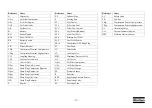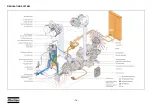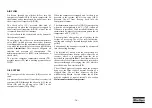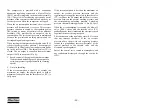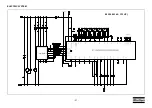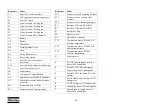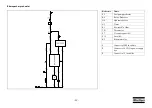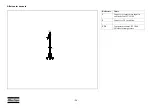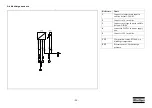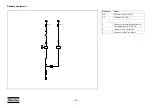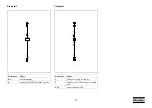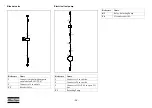
- 13 -
SPECIFIC SAFETY PRECAUTIONS
Batteries
When servicing batteries, always wear protecting
clothing and glasses.
1 The electrolyte in batteries is a sulphuric acid
solution which is fatal if it hits your eyes, and
which can cause burns if it contacts your skin.
Therefore, be careful when handling batteries,
e.g. when checking the charge condition.
2 Install a sign prohibiting fire, open flame and
smoking at the post where batteries are being
charged.
3 When batteries are being charged, an explosive
gas mixture forms in the cells and might escape
through the vent holes in the plugs. Thus an
explosive atmosphere may form around the
battery if ventilation is poor, and can remain in
and around the battery for several hours after it
has been charged. Therefore:
- never smoke near batteries being, or having
recently been, charged,
- never break live circuits at battery terminals,
because a spark usually occurs.
4 When connecting an auxiliary battery (AB) in
parallel to the unit battery (CB) with booster
cables: connect the + pole of AB to the + pole of
CB, then connect the - pole of CB to the mass of
the unit. Disconnect in the reverse order.
Pressure vessels
Maintenance/installation requirements:
1 The vessel can be used as pressure vessel or as
separator and is designed to hold compressed air
for the following application:
- pressure vessel for compressor,
- medium AIR/OIL,
- and operates as detailed on the data plate of the
vessel:
- the maximum working pressure ps in bar (psi),
- the maximum working temperature Tmax in
°C (°F),
- the minimum working temperature Tmin in °C
(°F),
- the capacity of the vessel V in l (US gal, Imp
gal, cu.ft).
2 The pressure vessel is only to be used for the
applications as specified above and in accordance
with the technical specifications. Safety reasons
prohibit any other applications.
3 National legislation requirements with respect to
re-inspection must be complied with.
4 No welding or heat treatment of any kind is
permitted to those vessel walls which are exposed
to pressure.
5 The vessel is provided and may only be used with
the required safety equipment such as
manometer, overpressure control devices, safety
valve, etc.
6 Draining of condensate shall be performed daily
when vessel is in use.
7 Installation, design and connections should not be
changed.
8 Bolts of cover and flanges may not be used for
extra fixation.
9 (Pressure) vessel maintenance is to be performed
by Atlas Copco.
Safety valves
Operating & Maintenance
Only trained and technically competent personnel
should consider overhaul, re-set or performance
testing of safety valves.
The safety valve is supplied with either a lead security
seal or crimped cover to deter unauthorised access to
the pressure regulation device.
Under no circumstances should the set pressure of the
safety valve be altered to a different pressure than that
stamped on the valve without the permission of the
installation designer.
If the set pressure must be altered then use only
correct parts supplied by Seetru and in accordance
with the instructions available for the valve type.
Safety valves must be frequently tested and regularly
maintained.
The set pressure should be periodically checked for
accuracy.
When fitted, the lifting device should be operated at
pressures not less than 75% of the set pressure to
ensure free and easy movement of internal parts.
The frequency of tests is influenced by factors such as
the severity of the operating environment and
aggressiveness of the pressurised medium.
Soft seals and springs should be replaced as part of the
maintenance procedure.
Do not paint or coat the installed safety valve (see also
Maintenance schedule compressor
).
Summary of Contents for XRHS 1150 CD4 C3 WUX
Page 2: ......
Page 16: ... 16 Main parts ...
Page 18: ... 18 REGULATING SYSTEM ...
Page 21: ... 21 ELECTRIC SYSTEM 9822 0963 40 C13 HP ...
Page 105: ......
Page 106: ...www atlascopco com ...

















